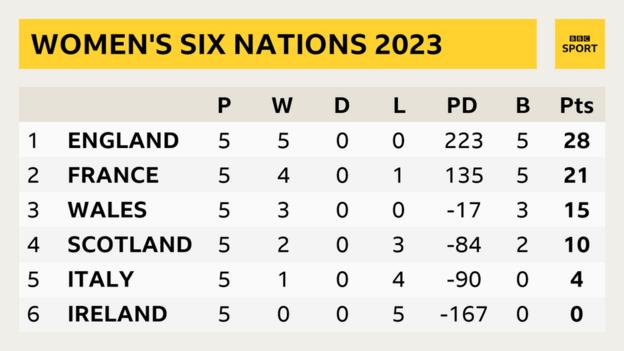[ad_1]
Another women’s rugby tournament has come and gone – and yet more records have been broken.
Building on the success of the 2022 World Cup in New Zealand, the 2023 Women’s Six Nations featured record home crowds for five of the six teams involved, with England’s 58,498 at Twickenham leading the way.
As the sport continues to evolve and grow, here are some of the key questions it faces.
How do teams keep growing crowds?
England created a template for a women’s rugby matchday, catering to a different Twickenham audience as far more women than usual flooded in.
The Sugababes were booked for half-time of the Red Roses’ Grand Slam victory against France and tickets priced at £20-£30 for adults and £5 for children brought more families in too.
Travelling around the country since 2018 has built England’s fanbase, culminating in Saturday’s world-record crowd.
“It is a very different crowd today – far more women and children,” BBC rugby union correspondent Chris Jones said on the Rugby Union Weekly podcast.
“The queue for food and merchandise was four times as long as the queue for Guinness. It’s very cool to see so many people here today who aren’t Twickenham regulars. It all contributed to it being a special day in English rugby history.”
With the exception of France’s 18,603 in Grenoble, the other records broken in the tournament are more modest.
Wales hosted 8,862 fans in Cardiff, Scotland were cheered on by 4,862 in Edinburgh and Italy welcomed 4,700 in Parma.
While a game at the Principality Stadium may still be a few years off for Wales, France could start to think bigger.
The Stade de France in Paris will be unavailable before it is used as an Olympic venue in 2024, but other stadiums for the 2023 men’s World Cup ranging from 33,000 to 70,000 capacity could be good options.

What about the one-sided scorelines?
Pre-tournament excitement about all the teams having contracted players for the first time has been tempered somewhat by lop-sided scorelines.
It will take time to close the gap with England and France, who have been professional for longer.
Wales – further into professionalism than Scotland and Ireland – showed signs of catching up and have climbed to their highest world ranking of sixth after finishing third in the championship.
Ioan Cunningham’s side were still beaten 59-3 by England and 39-14 by France, but did come out on top of a tight and entertaining game with Scotland in round two.
“There is such a gap between the top two and the rest,” England World Cup-winner Kat Merchant said.
“The Wales v Scotland game was really close, really exciting and people watching as neutrals thought ‘what a fantastic game’.
“We can’t see the 50-0s because it is just not good for any tournament.”
What will happen with contracts?
On the whole, contracts that allow players to be full-time athletes have understandably contributed to higher quality play.
But there is still progress to be made. Not all Ireland’s players accepted the contracts offered by their union and, given England have always led the way in this area, there are questions over whether Red Roses players should get a pay rise.
Contract values vary, but usually England players are paid about £30,000 for a one-year deal, with the list of those given contracts changing from year to year.
Rugby Players’ Association general secretary Christian Day is involved in discussions over a new deal for when the current contracts end this summer.
“We want a fair representation of what their value to the RFU is,” he said before Saturday’s Grand Slam win – the Red Roses’ fifth successive Six Nations title. “I think it’s rising.”
After Saturday’s victory, England prop Hannah Botterman said: “Obviously the RFU didn’t expect to get nearly 60,000 here. I think we doubled what they expected.
“There’s ongoing talks but we just want to keep the fans happy and keep them flooding these stadiums because it really does give us a boost.”
Merchant called for more “security” for England players on one-year contracts, saying: “Otherwise you start playing badly and you’re going to lose your income. If I was on £30,000 and I got let go, I would really struggle.”
What is the next big tournament?
This autumn World Rugby is launching WXV, a new three-tier global women’s tournament designed to give more teams regular, quality Test matches.
By finishing in the top three of the Six Nations, England, France and Wales have all qualified for the top tier, WXV 1, which will also include three teams out of Australia, New Zealand, Canada and the United States.
That is expected to be played in New Zealand in October, while the men’s World Cup is being played in France.
Scotland are in WXV 2 after finishing fourth in the Six Nations, their highest placing since 2017, but Ireland have gone in the wrong direction.
After winning the Six Nations eight years ago, Ireland finished sixth this year and will be in WXV 3. Italy will face a play-off against Spain for a place in WXV 2.
Former Wales captain Siwan Lillicrap reflected on the impact the new competition could have, saying: “We are seeing glimpses of how we compete with the best in the world.
“The more times we can play them the better we will be at that. Going into tier one of WXV will give us that opportunity to compete more often and close that gap.”


By Becky Grey
Source link




